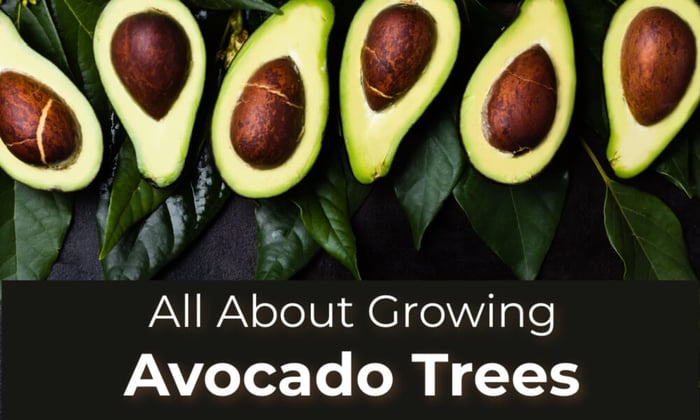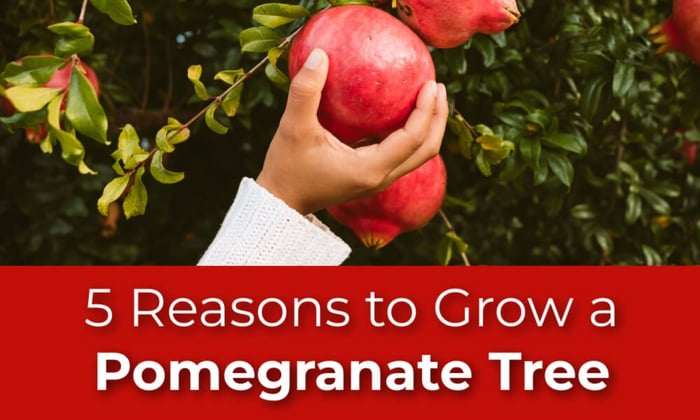All About Growing Avocado Trees:
Selection: Growing a Fruit Bearing Avocado from a Seed vs. Grafting
Many of us have tried to grow an avocado tree from an avocado pit. A popular method is to stick some toothpicks in a pit, let it root in a glass of water, and plant the seed in the soil. Over time, you will grow an avocado tree.
Does this work? While an avocado tree will grow, growing an avocado from seed in water will not guarantee that it will ever produce good-quality avocado fruit. If it does, it can take upwards of 10-15 years. That is because avocados have genetic variability, which means it does not always produce the exact variety of the seed parent.
The best way to grow an avocado tree that bears fruit is to graft a scion onto a proven fruiting avocado rootstock. A grafted tree can expect to fruit in years 4-5 with proper care and maintenance. The rootstock is chosen for its cold hardiness and resistance to disease.
Choose the right avocado variety for your climate. Hass and Pinkerton, for example, will not survive freezing temperatures without frost protection. In California, avocado trees can be considered self-fruitful. They will produce more fruit if you have an A and a B type tree, but you will still get fruit is there is just one.
Avocado trees grow best planted in the ground in consistently warm climates. They typically do tolerate temperatures below 50 degrees F.
Avocado Flavors
Avocados are undoubtedly one of the most popular fruits in American cooking. With the rise of avocado toast and the popularity of America’s favorite condiment, guacamole, we eat an average of 8 pounds of avocados per year. This is a huge increase from 2001, which was 2 pounds per year!
Commercially, 95% of the avocado crops in California are Hass, which has a season from fall to spring. This is because the main industry in Southern California has the perfect conditions to grow these creamy, delicious multi-purpose avocados.
The flavor of avocados depends on the maturity of the fruit. An unripe, unseasoned avocado can have an unpleasant hard texture and have a tasteless flavor, almost of nothing. As the fruit ripens, it becomes softer and more creamy, and the flavor will intensify. Waiting too long to eat your avocado could result in a mushy, bitter taste that is very unappealing. Luckily, an overripe or bad avocado is apparent once you cut it open. It will look brown and as if it is rotten inside.
For a year-round harvest we recommend that you plant:
Late Summer/Fall: Stewart, Mexicola Grande, Holiday
Winter: Fuerte, Pinkerton, Holiday
Caring for an Avocado Tree
Planting: Avocado trees thrive planted when in the ground with well-draining soil and full sun. Heavy clay soils are not ideal for avocados but building a mound above the native soil level with a well-draining mix of sand, compost, and fine mulch to get your tree up off the clay. This mound should be taller than your tree pot is deep and about 6' around. Once your ground is prepped you can dig a hole in your soil as deep as your tree pot and make sure to plant no deeper than the soil level of the tree. Avoid pilling up any soil against the trunk as this can encourage rot and fungal activity along the trunk. If you live in a climate that regularly drops below 32°F you will need to provide frost protection during winter or grow indoors as the cold will severely damage your tree.
Container Planting: When growing in a container, you need to provide a lot of space for the roots to spread out, and can be more difficult for it to bear fruit. A common variety grown in pots is the Little Cado, which is a small avocado fruit variety with very low vigor. Avocados should be shifted to a larger container annually to make sure you have space for the spreading root system. Start with a container that is about twice the size of the current one and eventually you should reach a 40-gallon container and a large tree that can support fruit. Much like outdoor growing, you want to provide a warm location with 8+ hours of sun a day and plant in a well-draining soil mix.
Watering: Avoid overwatering or keeping the roots wet, as they are susceptible to fungus and root rot. A regular watering schedule is important for the success of your tree, but do not overwater. Avocados prefer infrequent, deep watering. You want to wait for the tree's roots to dry out before watering again.
Mulching & Fertilizing: Providing a thick layer of mulch is a good way to help your tree retain moisture, improve soil quality and keep the roots warm during the cold months. Apply a 3 to 4-inch layer of mulch in spring and fall under the canopy of the tree, keeping away from the trunk of the tree. This is also an ideal time to fertilize with a balanced avocado/citrus fertilizer (follow manufacture-provided instructions). Good organic plant foods include composted manure, blood meal, fish emulsion, alfalfa meal or vermicompost.
Pruning: Keep pruning to a minimum in order to shape and control size. Frequent pinching of young trees is a good method to shape the tree, rather than heavy pruning. You do not want to expose too much of the trunk to the sun as avocados are susceptible to sunburn. If you do see that you aren't getting enough leaf coverage on the trunk it is common practice to paint your tree with tree paint or Plant Guard to protect it from sunburn.
During the summer, it is vital that you protect your trees from intense sun and any temperatures in excess of 90°F with either some kind of shade cloth or tree paint.
Check out Growing Avocados for more information!
Co-Author: Israel Osuna
Source: https://gregalder.com/yardposts/what-kind-of-avocado-tree-do-you-get-when-you-plant-a-seed/
Source: https://www.epicenteravocados.com/faq/




